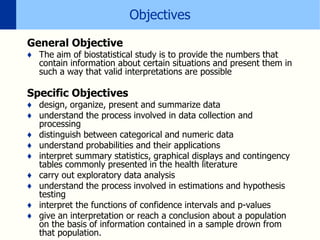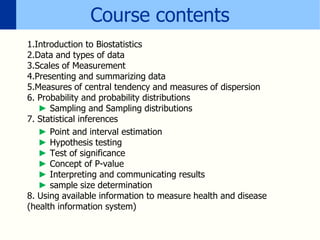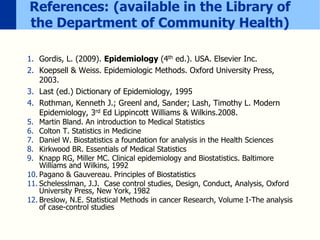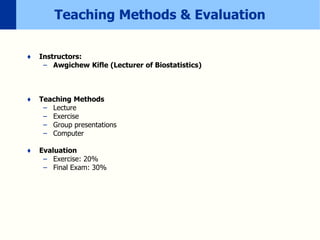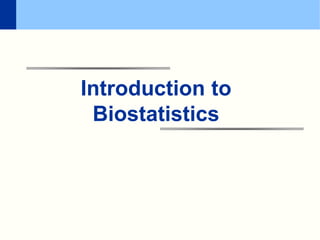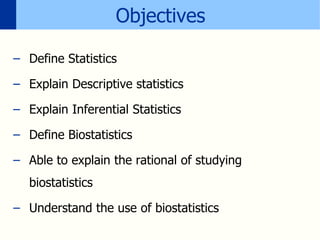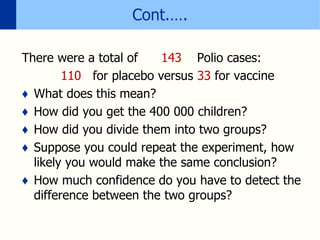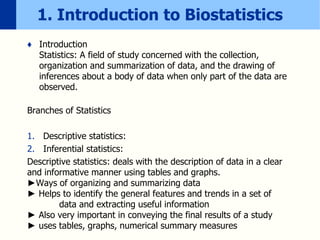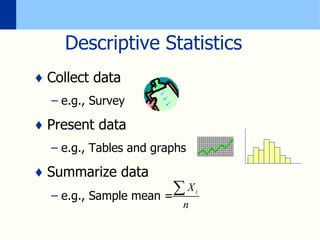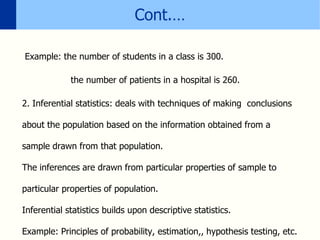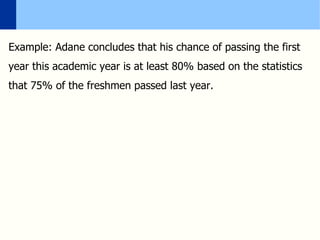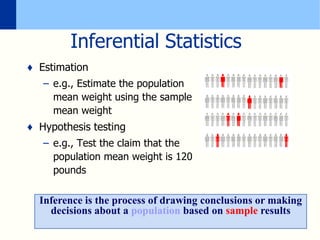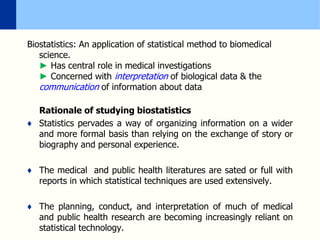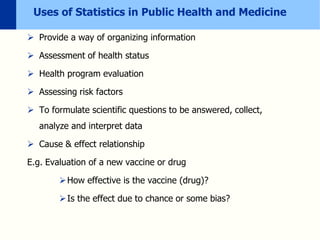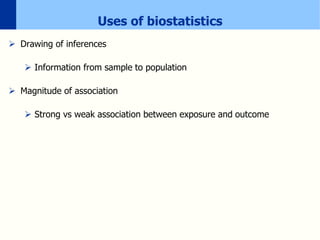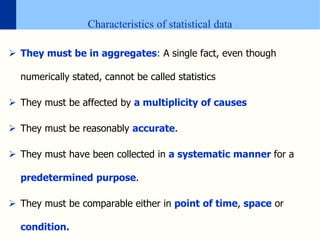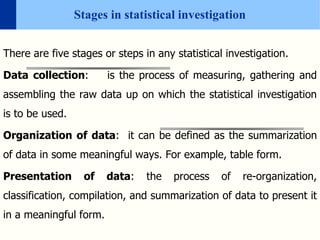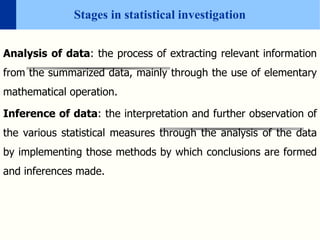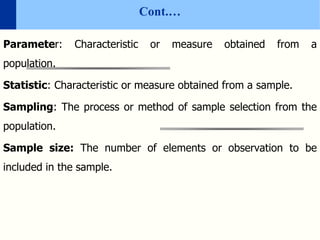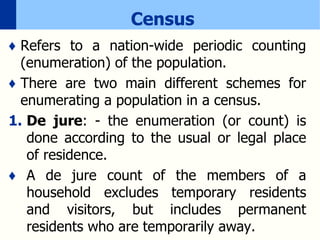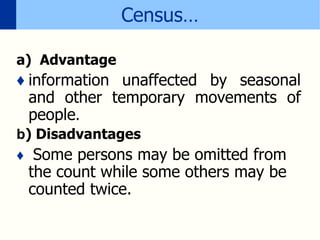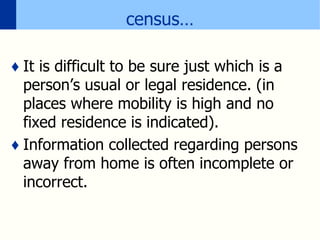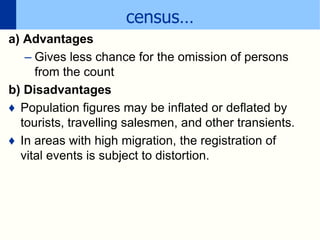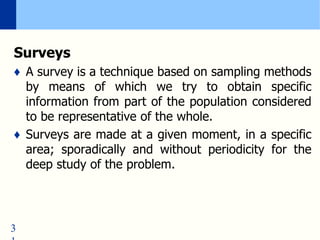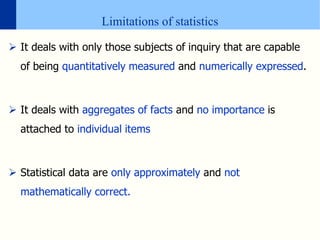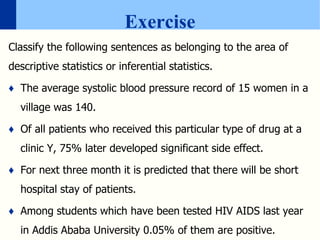1. Introdution to Biostatistics.ppt
- 1. School of Public Health Biostatistics
- 2. Objectives General Objective ♦ The aim of biostatistical study is to provide the numbers that contain information about certain situations and present them in such a way that valid interpretations are possible Specific Objectives ♦ design, organize, present and summarize data ♦ understand the process involved in data collection and processing ♦ distinguish between categorical and numeric data ♦ understand probabilities and their applications ♦ interpret summary statistics, graphical displays and contingency tables commonly presented in the health literature ♦ carry out exploratory data analysis ♦ understand the process involved in estimations and hypothesis testing ♦ interpret the functions of confidence intervals and p-values ♦ give an interpretation or reach a conclusion about a population on the basis of information contained in a sample drown from that population.
- 3. Course contents 1.Introduction to Biostatistics 2.Data and types of data 3.Scales of Measurement 4.Presenting and summarizing data 5.Measures of central tendency and measures of dispersion 6. Probability and probability distributions ► Sampling and Sampling distributions 7. Statistical inferences ► Point and interval estimation ► Hypothesis testing ► Test of significance ► Concept of P-value ► Interpreting and communicating results ► sample size determination 8. Using available information to measure health and disease (health information system)
- 4. Use of Computers ♦ The use of statistical computer package for processing and analysis of data is an integral component of this course. ♦ What the microscope is to biology and what the telescope is to astronomy, the computer is to epidemiological research. ♦ Computers are reliable, portable, computationally powerful and easy to use. However they give you what you give them. Computer scientists refer to this principle as GIGO Garbage In, Garbage Out. ♦ There are many data base computer programs that can be used for data entry purposes. ♦ It is however helpful, if the data is entered into a program which is compatible with the statistical package to be used for analysis. ♦ In this course, we will use the Epi-Info, SPSS statistical package.
- 5. References: (available in the Library of the Department of Community Health) 1. Gordis, L. (2009). Epidemiology (4th ed.). USA. Elsevier Inc. 2. Koepsell & Weiss. Epidemiologic Methods. Oxford University Press, 2003. 3. Last (ed.) Dictionary of Epidemiology, 1995 4. Rothman, Kenneth J.; Greenl and, Sander; Lash, Timothy L. Modern Epidemiology, 3rd Ed Lippincott Williams & Wilkins.2008. 5. Martin Bland. An introduction to Medical Statistics 6. Colton T. Statistics in Medicine 7. Daniel W. Biostatistics a foundation for analysis in the Health Sciences 8. Kirkwood BR. Essentials of Medical Statistics 9. Knapp RG, Miller MC. Clinical epidemiology and Biostatistics. Baltimore Williams and Wilkins, 1992 10. Pagano & Gauvereau. Principles of Biostatistics 11. Schelesslman, J.J. Case control studies, Design, Conduct, Analysis, Oxford University Press, New York, 1982 12. Breslow, N.E. Statistical Methods in cancer Research, Volume I-The analysis of case-control studies
- 6. Teaching Methods & Evaluation ♦ Instructors: – Awgichew Kifle (Lecturer of Biostatistics) ♦ Teaching Methods – Lecture – Exercise – Group presentations – Computer ♦ Evaluation – Exercise: 20% – Final Exam: 30%
- 8. Objectives – Define Statistics – Explain Descriptive statistics – Explain Inferential Statistics – Define Biostatistics – Able to explain the rational of studying biostatistics – Understand the use of biostatistics
- 9. Consider the following data ♦ Polio Vaccine: In the 1950’s polio was a serious disease that affected countless people (mostly children) ♦ In 1954, 401,974 children vaccinated 201,229 with a trial vaccine and 200,745 with a placebo There were a total of 143 Polio cases: 110 for placebo versus 33 for vaccine
- 10. Cont.…. There were a total of 143 Polio cases: 110 for placebo versus 33 for vaccine ♦ What does this mean? ♦ How did you get the 400 000 children? ♦ How did you divide them into two groups? ♦ Suppose you could repeat the experiment, how likely you would make the same conclusion? ♦ How much confidence do you have to detect the difference between the two groups?
- 11. 1. Introduction to Biostatistics ♦ Introduction Statistics: A field of study concerned with the collection, organization and summarization of data, and the drawing of inferences about a body of data when only part of the data are observed. Branches of Statistics 1. Descriptive statistics: 2. Inferential statistics: Descriptive statistics: deals with the description of data in a clear and informative manner using tables and graphs. ►Ways of organizing and summarizing data ► Helps to identify the general features and trends in a set of data and extracting useful information ► Also very important in conveying the final results of a study ► uses tables, graphs, numerical summary measures
- 12. Descriptive Statistics ♦ Collect data – e.g., Survey ♦ Present data – e.g., Tables and graphs ♦ Summarize data – e.g., Sample mean = i X n
- 13. Cont.… Example: the number of students in a class is 300. the number of patients in a hospital is 260. 2. Inferential statistics: deals with techniques of making conclusions about the population based on the information obtained from a sample drawn from that population. The inferences are drawn from particular properties of sample to particular properties of population. Inferential statistics builds upon descriptive statistics. Example: Principles of probability, estimation,, hypothesis testing, etc.
- 14. Example: Adane concludes that his chance of passing the first year this academic year is at least 80% based on the statistics that 75% of the freshmen passed last year.
- 15. Inferential Statistics ♦ Estimation – e.g., Estimate the population mean weight using the sample mean weight ♦ Hypothesis testing – e.g., Test the claim that the population mean weight is 120 pounds Inference is the process of drawing conclusions or making decisions about a population based on sample results
- 17. Biostatistics: An application of statistical method to biomedical science. ► Has central role in medical investigations ► Concerned with interpretation of biological data & the communication of information about data Rationale of studying biostatistics ♦ Statistics pervades a way of organizing information on a wider and more formal basis than relying on the exchange of story or biography and personal experience. ♦ The medical and public health literatures are sated or full with reports in which statistical techniques are used extensively. ♦ The planning, conduct, and interpretation of much of medical and public health research are becoming increasingly reliant on statistical technology.
- 18. Uses of Statistics in Public Health and Medicine Provide a way of organizing information Assessment of health status Health program evaluation Assessing risk factors To formulate scientific questions to be answered, collect, analyze and interpret data Cause & effect relationship E.g. Evaluation of a new vaccine or drug How effective is the vaccine (drug)? Is the effect due to chance or some bias?
- 19. Uses of biostatistics Drawing of inferences Information from sample to population Magnitude of association Strong vs weak association between exposure and outcome
- 20. Characteristics of statistical data They must be in aggregates: A single fact, even though numerically stated, cannot be called statistics They must be affected by a multiplicity of causes They must be reasonably accurate. They must have been collected in a systematic manner for a predetermined purpose. They must be comparable either in point of time, space or condition.
- 21. Characteristics of statistical data They must be in aggregates: A single fact, even though numerically stated, cannot be called statistics They must be affected by a multiplicity of causes They must be reasonably accurate. They must have been collected in a systematic manner for a predetermined purpose. They must be comparable either in point of time, space or condition.
- 22. Stages in statistical investigation There are five stages or steps in any statistical investigation. Data collection: is the process of measuring, gathering and assembling the raw data up on which the statistical investigation is to be used. Organization of data: it can be defined as the summarization of data in some meaningful ways. For example, table form. Presentation of data: the process of re-organization, classification, compilation, and summarization of data to present it in a meaningful form.
- 23. Stages in statistical investigation Analysis of data: the process of extracting relevant information from the summarized data, mainly through the use of elementary mathematical operation. Inference of data: the interpretation and further observation of the various statistical measures through the analysis of the data by implementing those methods by which conclusions are formed and inferences made.
- 24. Definition of Some Basic terms Population: is the totality of all subjects possessing certain common characteristics that are being studied. It is a collection of all units under investigation, which consists of a specified type of person or objects over a given space and time. Population should be defined on the basis of the objective of the study by the investigator. For example, it could mean the total human population of a country or village or a state; total number of school age population; total number of women in the reproductive age group, etc. Sample: is a sub group or part of the population selected by some methods in order to estimate the characteristics of the population.
- 25. Cont.… Parameter: Characteristic or measure obtained from a population. Statistic: Characteristic or measure obtained from a sample. Sampling: The process or method of sample selection from the population. Sample size: The number of elements or observation to be included in the sample.
- 26. Census ♦ Refers to a nation-wide periodic counting (enumeration) of the population. ♦ There are two main different schemes for enumerating a population in a census. 1. De jure: - the enumeration (or count) is done according to the usual or legal place of residence. ♦ A de jure count of the members of a household excludes temporary residents and visitors, but includes permanent residents who are temporarily away.
- 27. Census… a) Advantage ♦ information unaffected by seasonal and other temporary movements of people. b) Disadvantages ♦ Some persons may be omitted from the count while some others may be counted twice.
- 28. census… ♦ It is difficult to be sure just which is a person’s usual or legal residence. (in places where mobility is high and no fixed residence is indicated). ♦ Information collected regarding persons away from home is often incomplete or incorrect.
- 29. census… 2. De facto: - the enumeration is done according to the actual place of residence on the day of the census. ♦ A de facto count includes temporary residents and visitors, but excludes permanent residents who happen to be away on the day of the census.
- 30. census… a) Advantages – Gives less chance for the omission of persons from the count b) Disadvantages ♦ Population figures may be inflated or deflated by tourists, travelling salesmen, and other transients. ♦ In areas with high migration, the registration of vital events is subject to distortion.
- 31. 3 Surveys ♦ A survey is a technique based on sampling methods by means of which we try to obtain specific information from part of the population considered to be representative of the whole. ♦ Surveys are made at a given moment, in a specific area; sporadically and without periodicity for the deep study of the problem.
- 32. Limitations of statistics It deals with only those subjects of inquiry that are capable of being quantitatively measured and numerically expressed. It deals with aggregates of facts and no importance is attached to individual items Statistical data are only approximately and not mathematically correct.
- 33. Exercise Classify the following sentences as belonging to the area of descriptive statistics or inferential statistics. ♦ The average systolic blood pressure record of 15 women in a village was 140. ♦ Of all patients who received this particular type of drug at a clinic Y, 75% later developed significant side effect. ♦ For next three month it is predicted that there will be short hospital stay of patients. ♦ Among students which have been tested HIV AIDS last year in Addis Ababa University 0.05% of them are positive.
- 34. THANK YOU!!!

